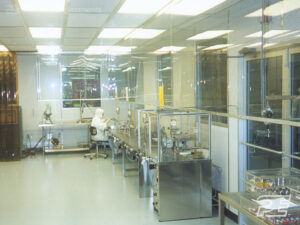Electrical Metrology Labs
Precision Environments Designs and Builds Electrical Metrology Labs Specifically Measuring the Four Fundamental Units of Electricity
Electrical Lab Design Features
Precision Environment’s electrical metrology laboratories can be designed for any size requirement with standard features such as shielded doors, power line filters, control line filters, data line filters, and wave guides. Typical design considerations include:
- Temperature Stability
- Temperature Gradients
- Cleanroom Cleanliness
- ESD Control
- EMI/RFI Attenuation
- Static Electricity
- Grounding
Electrical Lab Solutions
From concept through design and construction Precision Environments works interactively with each individual customer to develop an electrical metrology laboratory solution appropriate for the operational expectations and budget.
[1] Jeanneret, B., Benz, S. Application of the Josephson effect in electrical metrology. Eur. Phys. J. Spec. Top. 172, 181–206 (2009). https://doi.org/10.1140/epjst/e2009-01050-6
